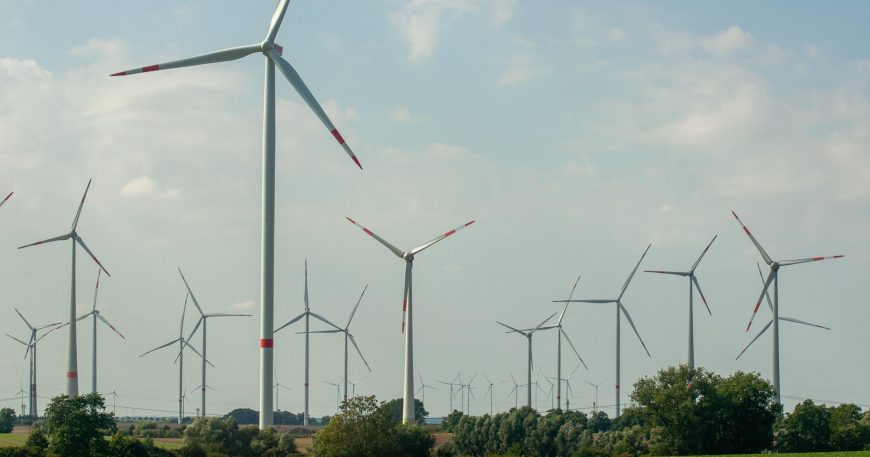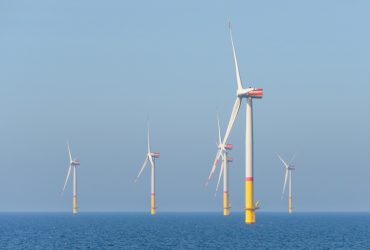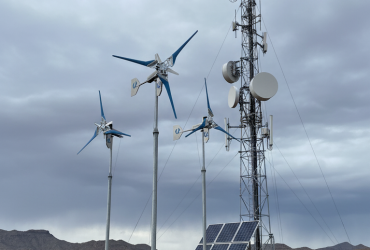
Agricultural Wind Turbine Selection Step by Step Process
Rising energy costs and unreliable grid connections push agricultural operations toward renewable power solutions that can slash electricity bills by thousands annually. Small wind turbines offer farms a path to energy independence while replacing expensive diesel generators and reducing operational costs.
This guide walks through the complete selection process, from measuring your site’s wind resource to choosing between turbine types, calculating costs, and navigating permits. You’ll discover how to match turbine capacity to your farm’s energy patterns and avoid the costly mistakes that derail many rural wind projects.
Wind Power Benefits for Modern Farms
Agricultural businesses choosing the right small wind turbine can reduce energy costs by 30-70% while gaining independence from unreliable grid connections. Wind systems replace diesel generators that burn expensive fuel and provide backup power during grid outages that can cost farms thousands in lost productivity.
Beyond cost savings, wind turbines help farms meet sustainability goals that increasingly matter to consumers and supply chain partners. Many agricultural operations discover that wind generation aligns well with their energy needs—windy periods often coincide with irrigation demands and grain drying operations.
Step-By-Step Turbine Selection Workflow
Choosing the right wind turbine for your farm follows an eight-step process that prevents costly mistakes and ensures long-term performance. Each step builds on the previous one, so skipping ahead often leads to oversized systems or poor site selection.
1. Define Load Profiles and Growth Plans
Start by gathering 12 months of electric bills to identify your farm’s energy patterns. Irrigation systems create summer spikes, livestock facilities draw steady year-round power, and grain handling equipment generates short bursts of high demand during harvest.
Calculate your average monthly usage in kilowatt-hours (kWh) and note seasonal variations. A dairy operation might use 2,000 kWh monthly year-round, while a grain farm could jump from 800 kWh in winter to 3,500 kWh during irrigation season.
2. Conduct Wind Resource Assessment
Wind speed determines everything about turbine performance—a site with 12 mph average winds produces twice the energy of an 8 mph location. Professional wind assessments cost $2,000-5,000 but prevent expensive mistakes on marginal sites.
You can start with free online wind maps, but these show general regional patterns rather than your specific microclimate. Buildings, trees, and hills within 500 feet of your planned turbine location can reduce wind speeds by 20-40%.
3. Select Rotor Type for Site Conditions
Horizontal axis turbines look like airplane propellers and work best in open fields with steady winds. Vertical axis turbines resemble giant egg beaters and handle gusty, turbulent conditions better but produce less power overall.
Most farms with adequate space choose horizontal turbines for their higher efficiency. Vertical turbines make sense near buildings or in tight spaces where wind direction changes frequently.
4. Size Rated Power and Hub Height
Match turbine capacity to your annual energy consumption, not your peak demand. A 10 kW turbine won’t actually produce 10 kW most of the time—it generates that power only in perfect wind conditions around 25-35 mph.
Tower height matters more than turbine size for energy production. Adding 20 feet of tower height often increases annual energy by 15-25% because wind speeds increase with altitude and become less turbulent.
Key sizing factors:
- Annual energy needs: Total kWh consumption from electric bills
- Average wind speed: Measured at proposed hub height
- Capacity factor: Percentage of rated power actually produced annually
- Future growth: Planned expansion or equipment additions
5. Compare Hybrid or Stand-Alone Configurations
Wind-only systems work well in consistently windy locations, but hybrid configurations often provide better reliability. Wind-solar hybrids generate power when the other resource is low—wind often peaks at night and during storms when solar panels produce nothing.
Wind-battery systems store excess energy for calm periods but add significant cost and maintenance complexity. Grid-tied systems without batteries cost less and let you sell excess power back to the utility when local net metering policies allow.
6. Run Cost and Payback Calculations
Small wind systems typically cost $3,000-8,000 per installed kilowatt depending on turbine size and site conditions. A 5 kW system might cost $20,000-30,000 including the tower, electrical work, and professional installation.
Federal tax credits currently cover 30% of system costs, and many states offer additional rebates or performance incentives. Simple payback periods range from 8-15 years in good wind locations with high electricity rates.
7. Check Permits and Grid Policies
Agricultural zoning usually allows taller turbines than residential areas, but you’ll still face setback requirements and height limits. Most jurisdictions require turbines to sit back 1.5-3 times their total height from property lines.
Grid interconnection policies determine how excess power gets credited to your account. Net metering lets you bank excess generation as credits, while feed-in tariffs pay cash for power you export to the grid.
8. Choose Certified Suppliers and Installers
Certified turbines meet safety and performance standards that protect your investment and may be required for tax credits. Look for IEC 61400-2 certification, which specifically covers small wind turbines under 200 kW.
Local installers familiar with your area’s permitting process and wind conditions often provide better long-term support than distant contractors. Ask for references from other agricultural customers and verify licensing and insurance coverage.
Understanding Your Farm’s Energy Demand
Agricultural energy use varies dramatically by operation type and season. Dairy farms maintain steady loads year-round for milking equipment and refrigeration, while crop farms show extreme seasonal swings during planting and harvest periods.
Irrigation represents the largest energy consumer on many farms, often accounting for 40-60% of total electricity use during growing season. Grain drying and handling equipment creates intense but short-duration loads that can stress undersized electrical systems.
Common agricultural energy patterns:
- Dairy operations: 15,000-50,000 kWh annually with steady monthly usage
- Grain farms: 5,000-25,000 kWh annually with summer irrigation peaks
- Livestock facilities: 8,000-30,000 kWh annually for ventilation and feeding systems
- Greenhouse operations: 20,000-100,000 kWh annually for climate control
Understanding these patterns helps size wind systems appropriately. A turbine that meets average demand might fall short during peak irrigation months unless you plan for seasonal variations.
Measuring the On-Site Wind Resource
Wind measurement separates successful projects from expensive mistakes. Professional assessments use meteorological towers or remote sensing equipment to measure wind speeds at your planned turbine height over 6-12 months.
Turbulence intensity matters as much as average wind speed for small turbine performance. Smooth, steady winds produce more energy than gusty conditions with the same average speed because turbines operate more efficiently in laminar flow.
You can estimate wind potential using online databases like the Wind Prospector or state wind maps, but these tools show regional patterns rather than site-specific conditions. Buildings, trees, and terrain features create local wind shadows that can reduce energy production by 30-50%.
Choosing Between Vertical and Horizontal Turbines
The choice between horizontal and vertical axis designs depends on your site conditions, maintenance preferences, and performance priorities. Each technology offers distinct advantages for different farm applications.
HAWT Strengths in Open Fields
Horizontal axis wind turbines achieve higher efficiency ratings and benefit from decades of design refinement. These turbines work best in open agricultural fields where prevailing winds blow consistently from one direction.
HAWTs require proper alignment with wind direction through automatic yaw systems that track wind changes. Their three-blade design captures maximum energy from steady winds but performs poorly in turbulent conditions near buildings or obstacles.
VAWT Advantages in Turbulent Yards
Vertical axis turbines accept wind from any direction without tracking systems, making them suitable for locations with variable wind patterns. Their lower profile and quieter operation work well near farm buildings and residential areas.
VAWTs typically produce 20-30% less energy than equivalent horizontal turbines but require less maintenance since most mechanical components sit at ground level. This trade-off between efficiency and convenience appeals to farmers who prefer simpler systems.
Feature | Horizontal Axis | Vertical Axis |
Efficiency | 35-45% | 25-35% |
Wind Direction | Tracks automatically | Accepts from any direction |
Turbulence Tolerance | Poor | Good |
Maintenance | Requires tower climbing | Ground-level access |
Noise Level | Moderate | Lower |
Calculating Rated Power and Tower Height
Turbine sizing balances energy production goals against system costs and local restrictions. Oversized turbines waste money in low-wind locations, while undersized systems leave energy potential unrealized during optimal conditions.
Capacity factor—the percentage of rated power actually produced annually—provides the best measure of turbine performance. Small wind systems typically achieve 15-25% capacity factors, meaning a 10 kW turbine produces about 13,000-22,000 kWh per year in good wind locations.
Tower height significantly impacts energy production because wind speeds increase with altitude and become less turbulent. The general rule places turbines 30 feet above any obstacle within 300 feet, but taller towers often justify their cost through increased energy production.
Evaluating Hybrid Wind Solar and Battery Options
Hybrid systems combine wind turbines with solar panels or backup generators to provide more consistent power throughout varying weather conditions. Wind and solar resources complement each other—wind often peaks during winter months and nighttime hours when solar panels produce nothing.
Wind Solar Hybrid Systems
Wind-solar combinations smooth power output and improve system reliability compared to single-resource installations. Solar panels produce peak power during calm, sunny afternoons when winds typically drop, while turbines generate electricity during storms and winter months when solar output falls.
Hybrid systems can reduce battery storage requirements for off-grid applications since combined generation better matches load patterns. Grid-tied hybrids maximize self-consumption and reduce electricity purchases during both sunny and windy periods.
Wind Diesel Hybrid Systems
Wind-diesel systems reduce fuel consumption and generator runtime while maintaining backup power reliability for critical operations. The wind turbine handles base loads during windy periods, while the diesel generator provides power during extended calm weather.
These configurations work particularly well for remote farms where fuel delivery costs are high or unreliable. Properly designed wind-diesel systems can reduce fuel consumption by 50-80% while extending generator lifespan through reduced operating hours.
Permitting, Zoning and Grid Tie Rules on Farmland
Agricultural properties often enjoy more favorable zoning for wind installations compared to residential areas, but regulations vary significantly between jurisdictions. Setback requirements typically range from 1.5-3 times total system height from property boundaries.
Height limits for agricultural zones commonly allow 100-150 foot structures, though some areas restrict turbines to 80 feet or require special permits for taller installations. Sound restrictions usually limit noise to 45-55 decibels at the nearest residence.
Common regulatory requirements:
- Building permits for towers and electrical connections
- Setback distances from property lines and residences
- Height restrictions and aviation clearance approvals
- Electrical permits for grid interconnection
- Environmental reviews for larger installations
Grid interconnection policies determine how excess generation gets credited and what technical requirements apply to your system. Net metering policies vary by utility and can significantly impact project economics.
Total Cost Incentives and Payback Period
Small wind system costs depend on turbine size, tower height, site preparation requirements, and installation complexity. Complete systems typically cost $3,000-8,000 per kilowatt installed, with smaller turbines costing more per kilowatt than larger units.
Typical cost breakdown:
- Turbine and tower: 60-70% of total project cost
- Installation labor: 20-25% including electrical and foundation work
- Permits and grid connection: 5-10% for regulatory compliance
The federal Investment Tax Credit currently provides 30% credit for qualifying small wind installations, while many states offer additional rebates or performance-based incentives. USDA Rural Energy for America Program grants can cover 25% of project costs for qualifying agricultural operations.
Simple payback periods typically range from 8-15 years depending on wind resource quality, electricity rates, and available incentives. Farms with high energy costs or excellent wind resources often achieve payback periods under 10 years.
Installation Maintenance and Remote Monitoring
Professional installation ensures proper system commissioning, warranty compliance, and optimal long-term performance. Tower work requires specialized equipment and safety training that most farmers lack, making DIY installation both dangerous and potentially warranty-voiding.
Preventive Maintenance Tasks
Small wind turbines require periodic maintenance to ensure reliable operation and maximize system lifespan. Most routine tasks can be performed by farm operators, while annual inspections typically require qualified technicians.
Owner maintenance includes:
Visual inspections of turbine, tower, and electrical connections
Cleaning debris from air intake screens and checking guy wire tension
Monitoring system performance through data logging equipment
Professional service includes:
Annual bolt torque verification and bearing lubrication
Electrical system testing and protection device calibration
Blade tracking adjustments and vibration analysis
SCADA and Fault Alerts
Modern wind systems include remote monitoring capabilities that track performance, detect faults, and optimize operation automatically. These systems provide real-time production data and maintenance alerts through web-based interfaces or smartphone apps.
Remote monitoring reduces maintenance costs by identifying problems before they cause system failures. Automated alerts notify operators of performance issues, allowing prompt action that minimizes downtime and repair costs.
Certified Turbine Vendor Checklist
Selecting reliable manufacturers and installers significantly impacts long-term system performance and maintenance costs. Certification standards provide quality assurance and may be required for incentive programs or utility interconnection approval.
IEC and UL Standards to Demand
International Electrotechnical Commission (IEC) 61400-2 certification specifically addresses small wind turbine safety, performance, and durability requirements. This standard ensures turbines undergo rigorous testing for power curves, noise emissions, and structural integrity.
Underwriters Laboratories (UL) certification covers electrical safety and grid interconnection requirements for turbines and associated equipment. UL-listed components are typically required by electrical codes and utility interconnection agreements.
Warranty and Spare Parts Support
Comprehensive warranties protect your investment and ensure system reliability throughout the expected 20-year lifespan. Look for manufacturers offering minimum 5-year equipment warranties and power production guarantees based on wind conditions.
Critical warranty elements:
Equipment coverage: Turbine, inverter, and major component defects
Performance guarantees: Minimum annual energy production commitments
Response times: Guaranteed service response for critical system failures
Parts availability: Local inventory for common replacement components
Move Toward Energy Independence With LuvSide
LuvSide specializes in compact, robust wind turbines designed specifically for agricultural applications and challenging rural environments. Our vertical and horizontal axis turbines deliver reliable performance while reducing operational costs and environmental impact for farm operations.
Whether you’re replacing expensive diesel generators or supplementing grid power during peak demand periods, LuvSide systems are engineered for consistent performance in agricultural settings. Our hybrid wind-solar configurations provide enhanced reliability while maximizing renewable energy production.
Contact us to discuss your renewable energy needs or request a consultation to explore how wind power can enhance your farm’s energy independence and profitability.
FAQs About Choosing the Right Small Wind Turbine for Agricultural Businesses
What wind speed is considered viable for small turbines?
Small wind turbines typically require average wind speeds of at least 10 mph for economic viability, with optimal performance occurring at 15-25 mph averages. Sites with lower wind speeds may still work if electricity rates are high or excellent incentives are available.
Can livestock or crop dust damage turbine blades?
Modern turbines are designed to withstand agricultural environments, though proper siting away from livestock areas and coordination with aerial applications is recommended. Most turbines install at heights well above typical agricultural aircraft operations.
How loud are small turbines at common farm distances?
Well-designed small turbines produce minimal noise comparable to background wind sounds when properly sited at recommended distances from buildings. Noise levels typically measure 40-50 decibels at 100 feet, similar to moderate rainfall.
Do small wind systems qualify for government grants?
Many agricultural wind systems qualify for renewable energy incentives through various government programs. The USDA Rural Energy for America Program provides grants covering up to 25% of project costs for qualifying agricultural operations, while federal tax credits cover an additional 30%.
Related Comntent
Wind turbines are subject to strict regulations in the EU to ensure their safe operation even during power outages. An uninterruptible power supply (UPS) is...
Wind turbines are subject to strict regulations in the EU to ensure their safe operation even during power outages. An uninterruptible power supply (UPS) is...

